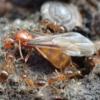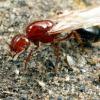Earlier this year I was able to attend the Ants of the Southwest course in Arizona. Here is the video suppliment of my trip, presented in a series of videos.
In the Getting There section I should emphasis you start in the town of Portal, AZ which is the easiest way to the station. There's another road that comes from Douglas, AZ but has a lot more water ways that flood over. Fording a river is not to be done lightly. An alarming amount of rocks and boulders will wash onto the road and remain hidden under the water.
Anting Methods
5:58 Just Look
7:58 Pitfall Traps and Baiting
12:28 Black Lighting
20:05 Winkler Sifting
Ray Mendez has worked in a variety of fields ranging from Advertising to creature effects in movies like "Alien" and "Silence of the Lambs." He's designed ant enclosures for museums such as those for the wildly successful California Academy of Science. More recently his setups were used in the documentary "Empire of the Desert Ants." We were honored to spend an afternoon with him and learn his tricks of the trade.
This video focuses on Western Harvester Ants, Pogonomyrmex. It was neat watching their interactions with Dorymyrmex insanus. In studies and books you always read about the harassing nature of Dorymyrmex species dropping dirt down the Pogonomyrmex nest entrance to gain extra foraging time. That was not the case here. In every instance it seemed the tables had turned and the Pogonomyrmex had the Dorymyrmex's trapped in their nests. Dorymyrmex of course have a more extensive colony network that seem loosely link together, where as one Pogonomyrmex nest will forage across the range of several small Dorymyrmex empires. The only time we witnessed the Dorymyrmex dropping dirt in the mounds of other nests is with colonies that lacked a layer of small pebbles around the entrance.
Come night fall the Aphaenogaster cockerelli take charge of foraging and begin moving their nests around. There is a type of scorpion which lives with these colonies that are roughly only the length of two A. cockerelli workers (with the tail curled). No one is sure what's going on here; if it's just males or females using the burrows, if they nest in just to lay eggs, because they're lazy, or if they're parasites or somehow benefiting the colony. Regardless, the ants don't seem to care these scorpions are in the nest. We otherwise just had fun looking at the colonies.
While there we encountered at least 3 species of army ant.
Neivamyrmex rugulosus which was near the station.
Neivamyrmex nigrescens which was farther up the mountain.
And Neivamyrmex opacithorax which was the smallest of the three and found out in the desert at night.
At least 4 males were found at black lights at night but identification of them requires dissection and examination of their reproductive parts.
Colony fragments were later released. (And likely dumped on other ant colonies to test the evacuation theory.)
This is just video of other ants we found mostly by walking around the station. There's no real focus but some of the ants are still pretty cool.
This one barely has any ants in it at all. There's a slight focus on wildflowers and what few ants there are happen towards the end of the video. This is more about following the water through a series of different environments. Over the course we visited a variety of different elevations. This was actually a combination of two or three different days but I edited it in such a way to tell a story. Two inches of rain overnight suddenly brings out all the waterfalls in the mountains, and these lead all the way down into the deserts. Small streams cut their way through unpaved roads and "washes" on desert land some of which haven't had water flowing through them for several years. A lot of it soaks back into the earth or meets up with a river or lake somewhere, but one place we visited was a dry salt marsh. Basically water flows in and evaporates out leaving behind a high salinity content in the "soil" where very few plants can grow, and yet we still found ants even in this harsh environment.
Edited by MrILoveTheAnts, June 1 2015 - 4:21 PM.






















